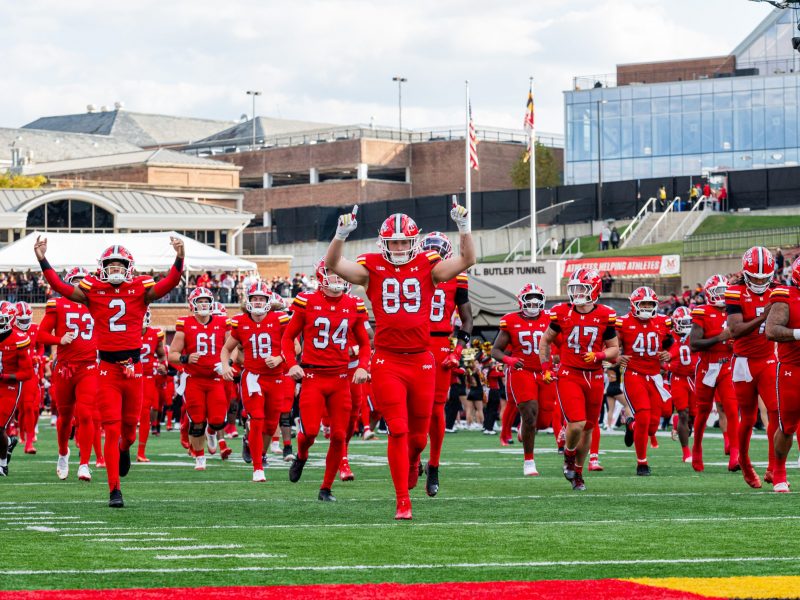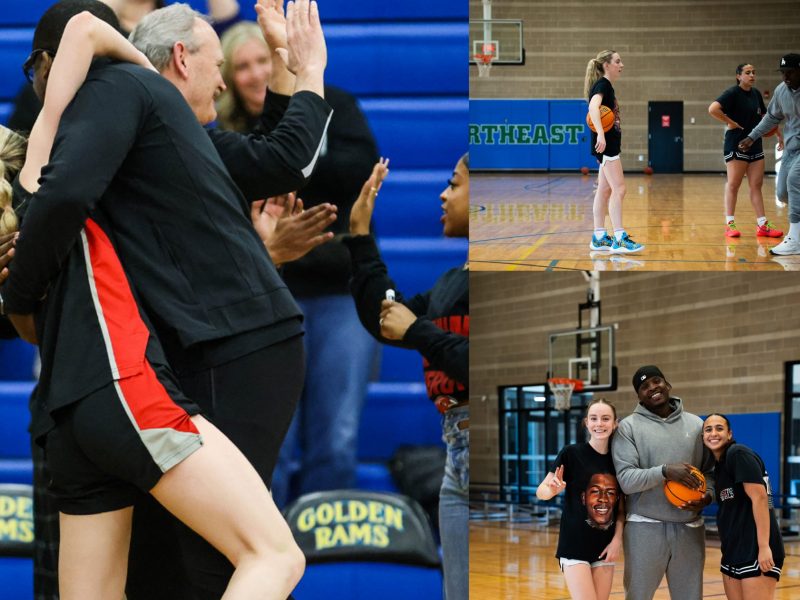
Shade Pratt
Minutes after Terrapins women’s soccer forward Shade Pratt scored her first goal of the season to give her team the lead against Iowa on Sept. 25, coach Jonathan Morgan made a game-changing decision.
Instead of leaving her on the frontline, Morgan gave Pratt the responsibility of defending Hawkeyes forward Cloe Lacasse — one of the best goal-scorers in the Big Ten. Early in the first half, Lacasse routinely sneaked behind the Terps defense.
Though Pratt’s transition to a new role weakened the Terps’ attack, her athleticism and physicality shut down Lacasse for the rest of the match. With Lacasse ineffective, the Terps left Iowa City with a 1-0 victory.
Throughout Pratt’s soccer career — which continues this weekend with trips to Minnesota and Wisconsin — and in other aspects of college life, she has learned to adapt quickly to different situations.
Whether she’s playing multiple positions in soccer, balancing her time between the pitch and the track or creating her own major, Pratt’s versatility has helped her thrive during her time in College Park.
“She loves to run; she loves to play soccer,” said her mother, Annie Pratt. “And she loves to do her schoolwork. She just loves to be successful in anything she does.”
MOVING AROUND
During her first three seasons as a part of the Terps women’s soccer team, Pratt focused on preventing goals rather than scoring them.
After playing sparingly in her freshman season, the Rosemount, Minnesota, native made 21 appearances during her sophomore campaign, and her performance at the wide midfield and wide back positions helped the Terps (5-4-6, 3-2-5 Big Ten) reach the second round of the NCAA tournament in 2012.
But in the past two seasons, Pratt has played two unfamiliar positions. After playing center back last season, Pratt made her season debut at forward against N.C. State on Aug. 31.
Morgan’s decision to move Pratt to the frontline was due to a barrage of injuries that kept multiple Terps forwards sidelined early on. Since starting against the Wolfpack, Pratt has been a fixture on the Terps’ attack.
“Her versatility has allowed us to be pretty good,” Morgan said. “We’ve been able to use her in different roles.”
Pratt, who leads the team with three goals, has thrived in her new role. And when she returns to her home state to play Minnesota tonight, she’ll hope to display her scoring prowess in front of her mother.
“I follow every game,” Annie Pratt said.
And though the season is coming to an end, Annie Pratt will still have the chance to watch her daughter compete for the Terps.
It’ll just be in a different sport.
TWO-SPORT STAR
Before Pratt set foot on the campus, she knew she wanted to be a two-sport athlete.
“I always wanted to do it,” Pratt said, “but I definitely wanted to be recruited for soccer. And then after that, see if the track team wherever I wanted to go would be willing to accept me.”
So when Pratt came on a visit to this university and met with former Terps women’s soccer coach Brian Pensky, she expressed interest in becoming a sprinter for the track and field team as well.
Pratt said Pensky wasn’t opposed to the idea, which led her to walk into the track and field office nearby and speak with the coaches.
“We had a little chat and they showed interest, so that was a good sign,” Pratt said.
Almost four years later, Pratt has excelled both on the field for Morgan and on the track with coach Andrew Valmon. Morgan has expressed confidence in the 5-foot-7 senior by starting her in every game this year, and Valmon is confident Pratt will perform well in her final season as a competitor in the 400 meters.
“I have high goals for Pratt that I think she can achieve this season,” Valmon wrote in an email. “Her mentality to be the best she can be is in place, and that’s how you become a champion.”
To compete in both sports, Pratt returns to College Park early in the summer for the soccer preseason and competes in the fall, then comes back from winter break early to train for the indoor track season before running outdoor track in the spring.
While track takes up two seasons of training, Pratt — with the help of her coaches — finds time to improve her soccer skills as well. Whether she is cooling down with a soccer ball during a track practice or attending a training session with the soccer team during the offseason, Pratt makes each sport a priority.
“They kind of want me to be not just a two-sport athlete that’s kind of good at both,” Pratt said, “but the best I can be at both.”
Morgan understands Pratt’s passion for both soccer and track and field, but he realizes her potential had she pursued one sport wholeheartedly.
“If [Pratt] ever focused on one, she probably would have had the chance to be an All-American at that one,” Morgan said. “But because she’s been divided, she probably hasn’t maxed out as much as she possibly could have.”
Though Morgan’s point is valid, it never crept into Pratt’s mind.
She hasn’t even considered which sport she’s better at.
“I don’t know,” Pratt said. “I love both of them.”
MANUFACTURED MAJOR
While balancing the demands required of a multisport athlete, Pratt struggled to decide on a major.
“My end goal is to get my masters in industrial design, which is something that we don’t offer here at Maryland,” Pratt said.
According to architecture professor Madlen Simon, her subject was the closest major to Pratt’s interests. However, Pratt couldn’t declare the major because her role as a student-athlete caused a time conflict.
But Pratt was used to figuring out solutions to these types of situations. On the soccer field, she adapted her style of play to offense and defense. And depending on which sport she was playing, she would train differently.
So without a clear major in mind, Pratt came up with an alternative plan. Through the individuals studies program, Pratt created a major called design in the built environment, which encompassed art, architecture and engineering courses.
“It’s a difficult degree,” Morgan said. “It’s not a fluff degree. And the fact that she had to create it herself is that much more impressive.”
First, Pratt needed to find a faculty mentor. She chose Simon, who taught an architecture class Pratt took. Then she had to create a proposal, which spanned about 10 pages, and present it in front of a board that decides whether to approve the plan.
After 24 hours, Pratt received a phone call notifying her of the approval of her proposal.
Simon, who spent significant time with Pratt during the process, said she thoroughly enjoyed her experience with the soccer star because of Pratt’s passion for architecture.
And though Simon doesn’t stand at the helm of an athletic program, she understands that Pratt’s ambition to be successful stretches far beyond the field of play.
“I could definitely compare … her performance as a student to her performance as an athlete,” Simon said. “She knows what excellence is and how to work hard and how to keep focused on the goal and succeed.”



